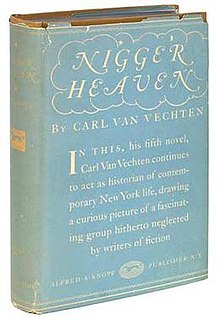Nigger Heaven

First edition of the text, with original dustwrapper, published in 1926.
|
|
| Author | Carl Van Vechten |
|---|---|
| Country | United States |
| Publisher | Alfred A. Knopf |
|
Publication date
|
1926 |
| Media type | Hardback |
| Pages | 286 |
| OCLC | 647060292 |
Nigger Heaven is a 1926 novel written by Carl Van Vechten, set during the Harlem Renaissance in the United States in the 1920s. The book and its title have been controversial since its publication.
The novel is a portrayal of life in the "great black walled city" of Harlem. It describes the interactions of intellectuals, political activists, bacchanalian workers, and other Harlem characters. The plot of the novel concerns two people, a quiet librarian and an aspiring writer, who try to keep their love alive as racism denies them every opportunity.
This roman à clef became an instant bestseller and served as an informal pocket guide to Harlem. It also split the black literary community, as some, e.g. Langston Hughes and Nella Larsen, appreciated it, while others like Countee Cullen and W. E. B. Du Bois, regarded it as an "affront to the hospitality of black folks". The book fuelled a period of "Harlemania", during which the area of Harlem became en vogue among white people, who then frequented its cabarets, bars, and so on.
It is also believed to be the source of the phrase, "stop on a dime."
Van Vechten by the 1920s was a noted music and dance critic in New York. Knopf had already published several of his novels by the time Nigger Heaven was conceived. He first became fascinated with Harlem when he read a book by a young black (Negro) writer, Walter White. He sought out White, who worked for the NAACP, and White introduced him to many black artists, which stimulated Van Vechten's appreciation for the Blues and for Harlem. Van Vechten wrote to Gertrude Stein that, "I have passed practically my whole winter in company with Negroes and have succeeded in getting into most of the important sets”, and told her of his future plans for "my negro novel". “This will not be a novel about Negroes in the South or white contacts or lynchings. It will be about NEGROES, as they live now in the new city of Harlem (which is part of New York).”
...
Wikipedia
